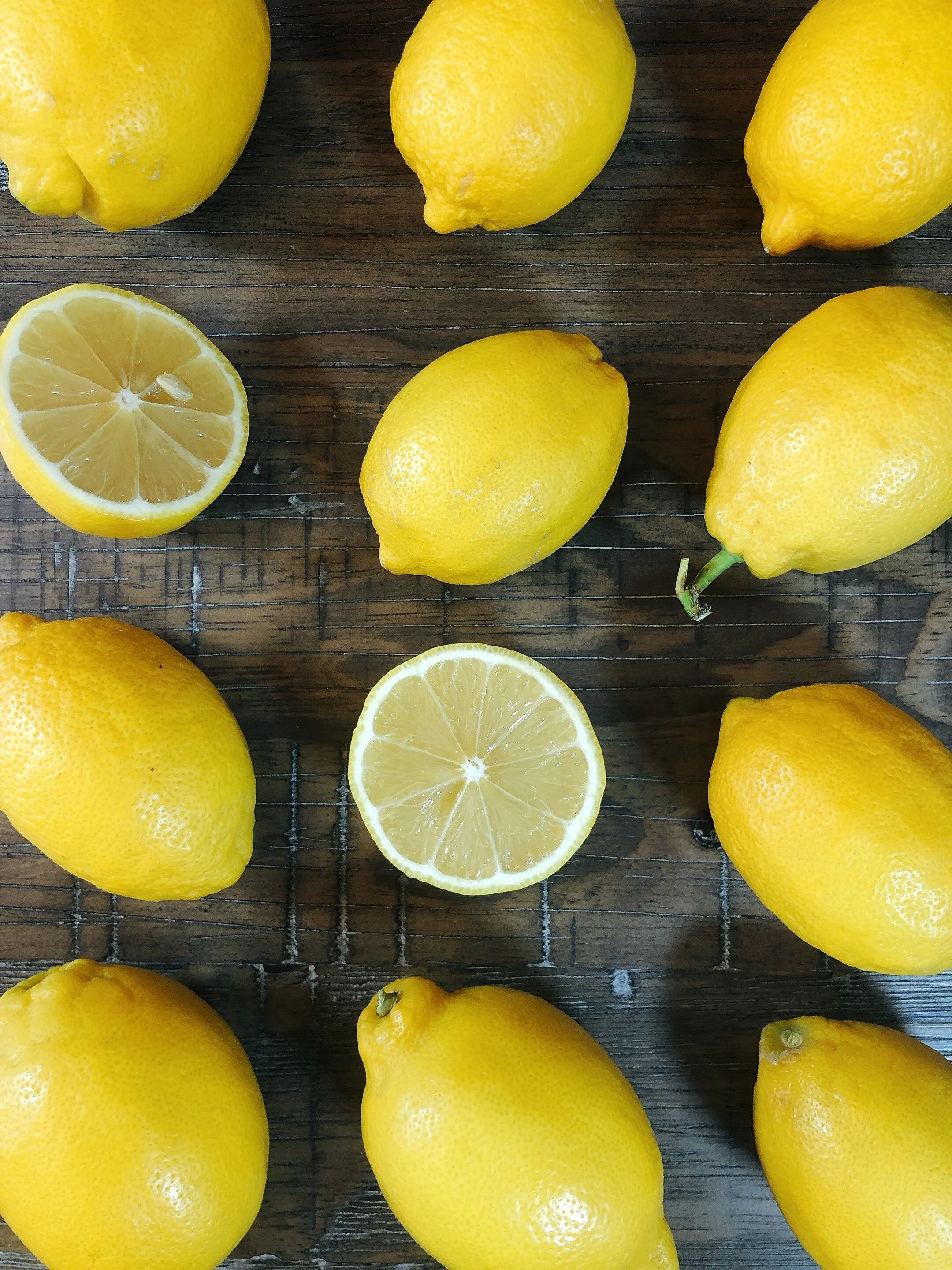Food Philosophy 2.0: Nourishment
“Eat food, not too much, mostly plants.” - Michael Pollen (1)
But also…
“Eat with complexity.” - Me
These lemons are bursting with vitamin C and antioxidants. Grown in my parent’s Arizona backyard, the sun soaked fruits are at their peak in nutritional value. Research has shown that the juice and peel of a lemon can ease stress, relieve stomach upset, lower blood sugar levels, improve iron absorption, prevent kidney stone formation, and reduce inflammation (2). Lemons are low in calories, high in nutrients, and versatile in cooking. From a nutritional standpoint alone, these fruits are a slam dunk.
However, this lemon tree consumes between 17 and 135 gallons of water daily depending on the time of year (3). In an arid climate, in a state experiencing its 21st year of drought, the large water consumption of a single tree is concerning, to say the least (4). Yet there are still more sides to the story of a lemon than just its nutritional makeup and its environmental impact. Lemons have a long culinary history in Middle Eastern, European, and African cuisines and are cherished in recipes across the globe. They were introduced to America in the Columbian exchange, and so their seeds were sewn with a colonizing hand and their history marred with that era’s infractions (5). Since the 1800’s American lemons have been predominately grown in California and Florida, and thus the lemon’s yarn is tangled with the legacy of agricultural labor, the plight of the honey bees, even the pathogenic greening destroying our citrus groves and the livelihood of human farmers (5, 6). To say the least, the lemon’s story is… complicated.
Unsurprisingly lemons are not alone in their complexity. Tea, meat, chocolate, milk, coffee, spices, chicken, potatoes, sugar, corn, honey, almonds, avocados, wheat, soy, salmon, and even bananas each have their own complicated histories, nutritional compositions, environmental footprints, cultural legacies, economic factors, and social implications. Nevertheless, the most common story we hear about our food today is that of nutrition. We are told time and again that we should or should not partake because such and such food is “good” or “bad” for us or our waistlines. Yet while nutrition may have become the largest looming thread in our collective discourse on wellness, it is not the only, or even the most important, narrative in dissemination. There are a plethora of stories and histories about food, and unless we attend to, investigate, and consider the deeply complex narratives informing our food choices, we cannot get to a truly well and nourished place.
You may be wondering why a move away from nutrition is even called for. What’s wrong with nutrition anyway? As the controlling narrative in discussions of wellness, nutrition certainly has our country deeply invested. We see this in the ever present nutrition labels on packaged goods, the calorie counts riding next to menu options at Starbucks, the enumeration of vitamins, antioxidants, and anti-inflammatory compounds found in recipe ingredients. The nutritional story is so embedded in American food that we can hardly get away from it. And unfortunately, it’s really doing us very little good on a national scale. On average 45 million Americans go on a diet each year. Americans spend $33 billion on diet foods annually, and yet almost 2 out of 3 American adults are overweight or obese. Obesity rates have only increased with the explosion of dieting in our country, and nutrition has yet to provide the magic bullet for this, our leading dietary problem (7).
While I acknowledge that the nutritional story of our foods can be informative and useful, it has never been complete or perfect. Many authors have established the long and fraught history of nutritional science. In Fear of Food: A History of Why We Worry About What We Eat, Harvey Levenstein details the contradictions underlying nutritional recommendations over the decades and how those guidelines have spurred public anxieties about food. From germs, to vitamins, to milk, to dietary fat, Levenstein exposes the radical shifts that have historically taken place in American opinions about the nutritional qualities of various foods. Most notably Levenstein reveals that changes in public perspectives on whether or not a food was “good” or “bad” occurred because of corporate interests and flawed scientific research (8). Today’s nutritional science may be more sound than that of decades previously, but the state of nutrition now is equally contradictory and anxiety provoking. Let’s put it this way: if nutritional science were effective, attainable, and well communicated to the American public, wouldn’t our country be in better physical health, especially given the amount of time, money, and energy we invest in diets and nutritious eating?
Despite this flawed legacy many of us, myself included, cling to a strong conviction that the nutritional makeup of our food influences our physical wellbeing. And unfortunately we’ve allowed our belief in nutrition, to our own detriment, to shoulder other food convictions out of the way, making itself the most recognizable and legitimate food story in circulation. So how is it that the nutritional story came to so control the dialogue on food and wellness? Simply put, the story nutrition spins has mass appeal. It fits neatly into our familiar narrative arch, complete with devastating conflict, a quest for the mystical cure, and a satisfying resolution. We can’t help but gobble that kind of tale right up.
The story goes something like this: you, our hero, have a health scare at your annual check-up. You embark on a journey to find the magic elixir. You seek far and wide, voyaging across book stores, natural groceries, and the internets. You encounter many enemies, “bad foods” that seek to derail your success. In your quest you also meet many allies, people who have a similar problem. They guide you to a mentor, a health guru, who hones the scope of your quest, and then low! you find at last: celery juice! or colloidal silver! or bone broth! You return home changed… for a time.
If this story sounds familiar, that’s because this is the same pattern all good stories follow, and the pattern exists because we love to see a terrible conflict resolved in a satisfying way. In stories we isolate heroes and villains and rarely examine the flaws of such a binary. And so this nutritional story rose to hegemony by pandering to our inability to resist the lure of a vanquished enemy (overweight and/or illness) and a happy ending (svelteness and/or wellness).
Real life, however, rarely follows the neat simplicity of a good story, and a single miracle cure is rare indeed. In actuality, life is messy and frequently dull. It is often littered with an abundance of conflicts that span the horizon to seemingly suffocate even the hope of a triumphant resolution. Yet there are real life heroes who solve real world problems. There are people who have found paths to their own wellness, and there are those who have made inroads on issues of racial injustice, environmental demise, and economic insecurity as they pertain to food and the unwell.
However, the heroic path to these solutions is not uncomplicated. None of these conflicts can be untangled and addressed without acknowledging the full scope of those conflicts’ stories and their interlocking factors. In Franchise: The Golden Arches in Black America, Marcia Chatelain seeks solutions to just such a conflict as she delves into the complex relationships between nutrition, fast food, and black Americans. She writes, “promoting healthy lifestyles can improve lives. But understanding how shifts in the priorities of the mid-century civil rights struggle, changes in federal policy on business and urban development, and the boom years of fast food converged in the lives of black America is equally critical” (9). In other words, if we want to promote wellness, we cannot simply propagate the nutritional diatribe. We need to attend to the other stories and histories that influence the opportunities and choices we all make about food.
Of course If we throw too many other storylines in with the nutritional narrative, things start to get messy. Discord erupts, and the happy ending that was only a meal, or a pill, or a diet away fades into a hazy horizon. This is the difficult part; we cannot cling to the safety of the nutritional story, as familiar and hopeful as it is, because it is always only going to be a single part of the larger story of any given food. In a world where half truths and single-sided stories are all too common, we know better than to seek wellness, true nourishment, there. Instead, we need to explore and listen to all the stories about food, and decide from there what we believe is most important.
Whether or not we recognize that we have beliefs about food, nutritional or otherwise, they are still there, floating around and influencing our eating decisions. Some of these beliefs may be straightforward and apparent, such as “cheeseburgers are delicious,” or, “I hate green beans.” Others may be calculated ethical values such as vegetarianism or localism. Still others may be rooted in identity and tradition. No matter what our beliefs are, in today’s world those food convictions are at least a little bit contradictory at times. If we believe in nutrition, how do we navigate our distaste for green beans? If we are vegetarian, how do we celebrate our family food traditions? If we want to eat locally, how do we navigate scarcity? If we want to have a plant based diet but live in a food dessert, how do we afford and access fresh produce? I’m not actually suggesting that we can even resolve the dissonance between these beliefs. But by listening to the various stories of our foods, bringing those tales to the table, and exploring, challenging, and eating through the complex beliefs we have about food, we may have a chance to better honor and nourish ourselves and the planet. We cannot get there, however, if nutrition is the only story we allow ourselves to subscribe to food.
This way of eating with complexity does not aim to move us along toward some kind of global nutritional outcome - a utopian world in which we’re all super fit centenarians. Rather, eating with complexity guides us to a world in which we live in harmony with our own beliefs, values, and choices about the foods we consume. It doesn’t mean giving up on our nutritional (or any other) goals; complex eating just means that we are attuned to all the factors influencing our decisions about food and prepared to navigate them in ways respectful to all our beliefs. In truth it’s the only way for us to succeed in our wellness goals. For some this may mean living without meat, or sugar, or wheat. For others it may mean culinary exploration and the honoring of tradition. And for others still, complex eating may be a bizarre mashup of these paths and many more. Whatever eating with complexity resembles, the peace we get from honoring our convictions about food and the myriad stories that inform those beliefs is at the root of a nourished life.
This brings me back to the lemon. I eat the lemons from my parent’s lemon tree. I eat them because I love lemon water, and lemon tea, and lemon bars. I eat them because the tree has been there almost as long as I’ve been alive, and it’s life is precious to me. I eat the lemons to remember weaving through the branches as a child, picking the fruit, dipping its sour flesh in the sugar bowl, and eating them, pucker faced, straight from the peel. I eat the lemons because I love to share the joy of harvesting fresh fruit with my children and because otherwise those lemons would fall to the soil and the birds and the javelinas. As I eat, I am bothered, and I wonder about water and how I can preserve our tree and this city I so cherish. Yet I eat the lemons, and I think about the nutrients and sunshine it took to grown them, and how grateful I am for their sweet sourness and the vitamins, and antioxidants, and anti-inflammatory compounds that feed my body. And I feel nourished.
1. . Pollan, Michael. Food Rules. New York, Penguin, 2011.
2. Bjarnadottir, Adda. “Lemons 101: Nutrition Facts and Health Benefits.” Healthline, 22 Mar. 2019, https://www.healthline.com/nutrition/foods/lemons. Accessed 28 Jan. 2021.
3. Wright, Glenn C. “Irrigating Citrus Trees. The University of Arizona Cooperative Extension, no. AZ1058, 2000, pp. 1, https://cals.arizona.edu/extension/ornamentalhort/landscapemgmt/general/citrusirrigation.pdf. Accessed 28 Jan. 2021.
4. “Arizona Drought.” Arizona State Climate Office, 28 Jan. 2021, https://azclimate.asu.edu/drought/#:~:text=Arizona%20is%20currently%20in%20our,of%20a%20long%2Dterm%20drought.&text=Since%20Arizona%20has%20an%20arid,few%20wetter%20than%20normal%20years. Accessed 28 Jan. 2021.
5. “Lemon History.” The Nibble, Apr. 2010, https://www.thenibble.com/reviews/main/fruits/lemon-types.asp. Accessed 28 Jan. 2021.
6. “Citrus Greening.” The US Department of Agriculture, https://www.aphis.usda.gov/aphis/resources/pests-diseases/hungry-pests/the-threat/citrus-greening/citrus-greening-hp. Accessed 28 Jan 2021.
7. “Weight Management.” Boston Medical Center, https://www.bmc.org/nutrition-and-weight-management/weight-management#:~:text=An%20estimated%2045%20million%20Americans,year%20on%20weight%20loss%20products. Accessed 28 Jan. 2021.
8. Levenstein, Harvey. Fear of Food: A History of Why We Worry about What We Eat. Chicago, University of Chicago, 2012.
9. Chatelain, Marcia. Franchise: The Golden Arches in Black America. New York, Liveright, 2020.


